The BlackBerry Storm. It feels like ages ago since we first broke news of this bad boy, but the release is finally right around the corner. Literally, it’s tomorrow! Need we say more? Heck yeah! We’ve got a pretty substantial review on the device and we’ve even taken the time to compare the Vodafone units to the Verizon units since we’ve got both in our office. First impressions? No way, you’re going to have to hit the jump for that. Just make sure you’ve got a couple Ritalins in your system — we go in!
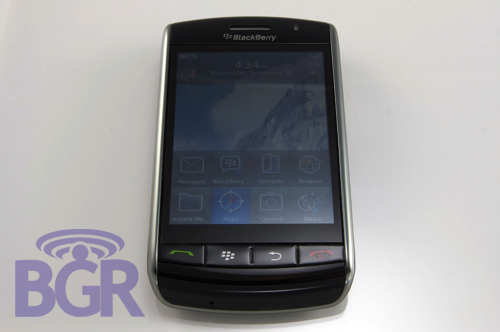
Screen (not including SurePress)
The capacitive screen on the BlackBerry Storm makes use of a gorgeous 480×360 display. That’s a full 40 pixels more than the iPhone/iPhone 3G, for those that are keeping score. While the screen isn’t as perfectly crisp and vibrant as the Bold, it’s definitely at the top of the list in terms of comparing it to other high-end smartphones. We’d much rather look at the Storm’s screen than even, let’s say, the Sony XPERIA’s. Even though for instance the Storm’s screen is basically half VGA compared to VGA, it just is more exciting to look at.
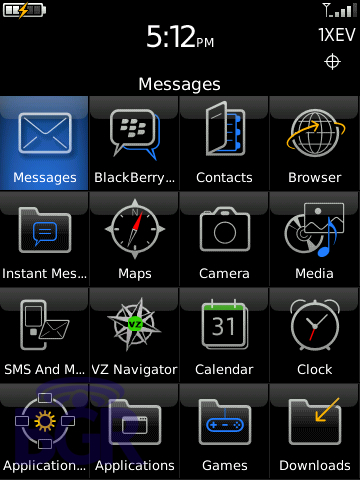
There’s one tiny, and we do mean tiny problem. You can see a checkered pattern of dots on top of the touch panel. Not below the digitizer or anything, right on top. There are around 18 x 12 dots (216) on the screen, presumably how the touch panel registers touch inputs. You can even see micro-fiber lines connecting the dots (har, har) and it looks like little “X”s on top of the screen. Now, these aren’t highly noticeable and we never even saw them until around the second day of use, but once you know they are there, they drive you crazy. Especially if you are a neat freak and keep thinking it’s dirt on your ‘Berry.
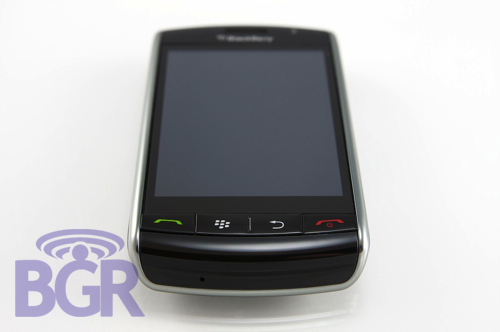
Build quality
We’re generally all around really impressed with the Storm’s build quality. The Bold was a little shady in some places and we’ve experienced plenty of problems regarding hardware failures there, but we’re pretty sure those things won’t occur on the Storm. You do have the most fragile part of the device front and center, and we’re not sure how resistive the capacitive screen (you like that?) will be to scratches and nicks. It’s not a cheap plastic material and it should fare decently well, though. Plus you can always get a screen protector if you’re really scurred.
If you shake the handset, there’s literally nothing that rumbles around. No buttons shake, the battery cover doesn’t move — it’s very solid. There are also no creaks whatsoever. It really feels like a tank, both in weight and in build quality. The silver bezel seems to be either the same material as the Bold or possibly a little better, though we wouldn’t count on that staying pristine if you ever drop it, scratch it, or anything else. You’ll most likely end up seeing the black plastic underneath the silver coating sooner or later.
For giggles we took apart one of our Vodafone Storms and were really surprised. It’s amazing that for the most part, RIM really refines their manufacturing and assembly process. We’d go out and venture to say that the Storm is probably RIM’s most solidly constructed BlackBerry in a very long time. Save for the adhesive that holds the bottom and top front panels on, this thing is iron-tight.
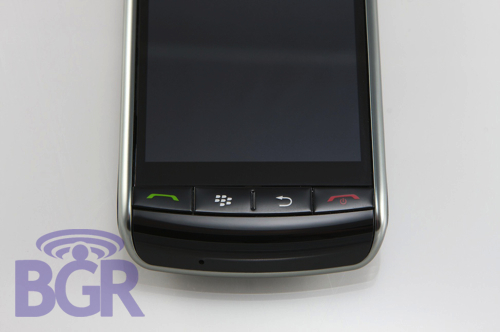
Feel
This is a little tricky… BlackBerrys have always been so comfortable to hold and use. The Storm is a little different. What really bothers us is the back of the device. The two metal battery latches on the two bottom rear sides makes the phone very uncomfortable to hold sometimes. Not when you hold it while “cupping your hand,” but when you hold it deep in your hand (like how I like to carry my Bold when it’s not in the holster), it sort of bothers you. The two rubber feet don’t bother us (though they do make the unit wobble if you try and type while it’s on a flat surface), but the metal latches really get in the way sometimes. The phone in general is incredibly solid-feeling, as we have come to expect from RIM. The screen assembly does feel a little cheap coincidentally though.
First, there’s the gap around the edges, likely necessary since the whole thing actually moves inward when pressed, but if you hold the screen with a finger and move your finger around, the screen will wobble back and forth. It’s not exactly a comforting feeling when everything else is so solidly constructed. The metal battery door is completely awesome and so necessary for all of you that abuse the crap out of your devices. Just think about your Curves and how scrizzy-scratched up those battery doors were! The right convenience key is placed a tiny bit too low for our comfort, and since this is made to be a one-handed device (at least in portrait mode), we kept thinking the unit would fall out of our hands whenever we tried to launch the camera using that key.
The Storm totally threw us for a loop at first. I had personally used a very, very early unit for literally probably 1-2 minutes a long time ago, but don’t remember it being this heavy. And don’t take that the wrong way, the phone isn’t necessarily snackin’ on McDonalds everyday, but it sort of messed with our minds as we expected it to be much lighter.
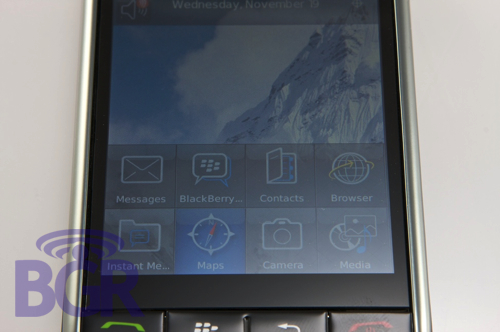
UI
There have definitely been some problems with the UI of the Storm, for us at least. We can’t help but feel like it was designed for three year-olds with tiny fingers. There’s been so many occasions where you think you are hitting the right selection but your touch registers the option below it. This makes it difficult to get things done sometimes because SurePress is effectively rendered useless in those situations. For instance, you want to hit Screen/Keyboard in options, yet it hits Security Options instead. Sure, you can slowly get the right selection down and then press in the screen. But if you’re in a hurry and just want to quickly browse, you should be prepared for some erroneous touch events.
Let’s talk about scrolling… There’s no “rubberband man” sexy scrolling here. Where your finger stops is where the scrolling stops. This is probably the single stupidest thing the Storm does. How in the hell are you supposed to scroll through an insanely long webpage? For instance, RIM’s sacrilegious terms and condition webpages when you want to download a RIM application. You want us to click the hardware menu key, scroll down the menu, click Show keyboard, and then finally use the space bar to help us down the page? RIM gives you up and down scroll buttons in some applications, but the one area where it is needed most (browser) is no where to be found.
RIM did the best they could here, but is it enough? We’re not sure. It’s sort of a wait-and-see thing, because it will depend on what your usage is like and how well you can adapt to a new user interface. It’s another one of those love-it-or-hate-it moments.
Hardware
RIM, Verizon, and Vodafone deserve massive lashings for the omission of Wi-Fi and a tri-band HSDPA radio. (Or the software-locked 2100MHz band at least, but we’ll cover that later). Like we said before, if you think you don’t need Wi-Fi, you are obviously not a smart person. It has nothing to do with the carrier’s data network. Yes, Verizon’s data network is better than AT&Ts. Congrats, VZW subscribers. The fact is that no carrier’s data network will ever compare to my 50Mbps cable modem or yours. Granted, the unit won’t come nearly close to those speeds if it had Wi-Fi, but still, a steady 3Mbps is a whole lot better than 500KBPS.
What about when your carrier is having data outages? No worries, just flip on that Wi-Fi switch, right? Wrong. What about when you travel for business or pleasure and the local coverage in that bad ass remote island location isn’t that great. Just flip on Wi-Fi since your hotel (or if you’re insane like us, you carry an Airport Express so you can Wi-Fi that shizz) offers Wi-Fi, right? Wrong. What happens when you work in a corporate office that gets horrible reception? Wi-Fi? Nope. What about when you’d like to connect your device to your home network, use VoIP applications, or just get a speedier web experience in general? You’re completely out of luck.
The removal of Wi-Fi (actually, a non-inclusion as RIM told us) in 2008 is absolutely atrocious and all three of those named above should be ashamed. Literally. It angers us that in this day and age carriers and manufacturers are still calling the shots for us, treating carriers as customers instead of customers as customers. This hasn’t been Verizon’s first crippling, and we anticipate it will not be their last. You can bet your ass on one thing though, if AT&T gets a version of the Storm, Storm 2, Storm 7, or what have you, it will certainly have Wi-Fi. It’s been confirmed to us by sources at RIM that what we said about Wi-Fi was absolutely correct: it’s not that there wasn’t room on the circuit board for the Wi-Fi chip, it’s that the carriers completely requested it to be not included.
The tri-band radio is another one of those situations. Listen, VZW, If someone wants to go and buy a Storm at full price from you and unlock the crap out of it, make your $100-$200 on the unit and keep it moving. That person wasn’t going to port their number over to you anyway if they are buying it outright to use on another network, so stop worrying about “lost revenue on data plans.” Make your easy money, and keep it movin’. If nothing else, that person’s Storm is Verizon-branded — free advertising. But, no, there is not a user-accessible tri-band HSDPA radio in the Storm, so anyone wishing to use an unlocked Vodafone unit will have to settle for EDGE and no Wi-Fi. Sorry, friends.
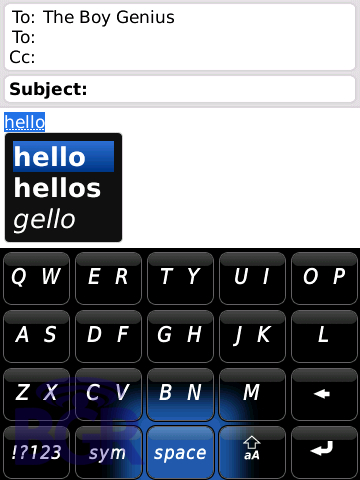
SurePress / Typing
This is going to be a hate or love it experience again, and we really aren’t feeling it since we’re power users. We would have loved a straight capacitive screen here. The button presses get tiring after you type a lot and we find that we just want to type less in general than we do on our Bolds and Curves. (I’m not going to out the one lone writer here at BGR who still has a Curve.) Here’s the issue… if you’re in SureType mode it’s not that bad, but when you switch to landscape mode, your finger covers up the letters and blue halo does little to reassure you what letter you’ve selected. The other issue is the actual hardware. I took apart the unit and found that there is one button in the middle of the screen which explains why it is so damn hard to press the screen on the edges. If you need to type an “a” key or “z” key or even select a menu option that’s on the edge of the screen, you will have to press very, very hard. This makes it really a chore to use sometimes.

The auto-correction on here is a total joke and barely works for anything we’re trying to type, and you just can’t type fast. Your typing speed is hardware-limited.
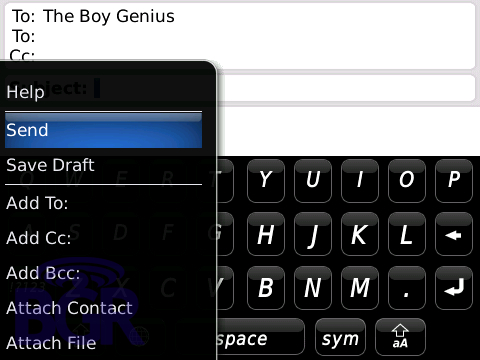
Not all is bad though… for anyone who loves their BlackBerry shortcuts (T for top, R for reply, etc.) those can all be done via the on screen keyboard when it’s shown. The shortcuts even work in SureType mode but you’ll have to remember what they are since they are different.
Gestures
While there’s pretty much no multi-touch support, besides maybe copy and paste (a royal pain in the ass to use effectively, but better than nothing), the Storm incorporates a ton of useful gestures to help make navigating easier. For instance, you can swipe left or right to flip through emails, texts, BlackBerry Messenger conversations, IMs, etc. There’s also gestures to show and hide the virtual keyboards. To pull up the keyboards you can either go into the menu and “show keyboard” or you can simply put your finger at the bottom of the screen and flick up. To hide it, you just flick down.Very, very useful when you don’t want to have to go hit the menu key, scroll down, and finally click, “Show keyboard.”
Gestures are also implemented in the photo browser so you’re able to swipe through your pictures with no problem at all. It sometimes doesn’t register correctly and you have to be a lot more precise than when using the same gestures on an iPhone let’s say, but it does work fine. To our surprise, the left/right swipe gestures actually don’t work in the browser for some reason. Not really sure why not, but it’s sort of hit or miss with what applications will accept gestures and which ones won’t.
Voice calling
It’s funny because the first time I went into the phone application, I couldn’t get the thing to dial a number. Quickly I realized that you had to physically push down on the screen, and all was well from there. Dialing phone numbers is actually our favorite part of the device. It just gives you a really reassuring feeling that you can quickly bang out a phone call without screwing up the number and having to retrace your steps. Verizon’s cellular network hand in hand with the Storm provide an absolutely pleasurable calling experience. Phone calls were crisp, clear, and the interface is really well designed. You’ve got speaker, mute, flash, and add participant keys right on the screen. At the bottom where the shortcut keys are always at, you have options for the dial pad, notes application, home screen, calendar and contacts. We had no problem multi-tasking while on a phone call, but not being able to use voice and data at the same time is really a problem once you’ve gotten used to it. Heck, our Messenger status won’t even say “On the Phone” anymore! Single tear.
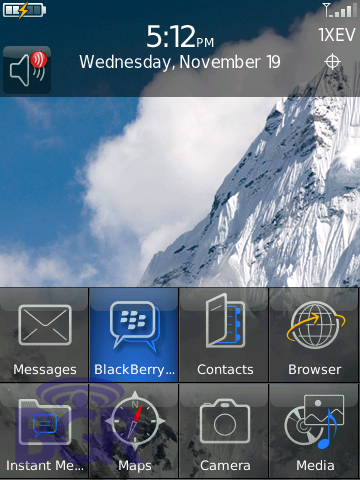
Reception
Here’s a shocker… the Vodafone unit constantly got 2-3 bars of EDGE reception on AT&T while every other AT&T device got 5 bars in the same location. Makes absolutely no sense, right? We’re going to wait until the unit is unlocked and not using a Vodafone SIM, but definitely not a great first start. As far as the Verizon unit goes… we’re seeing better results but not absolutely perfect signal pickup. Hopefully it’s because Verizon gave us not final software (more on that later) but this isn’t the best start. Again, in locations we’d get 4 bars of Verizon service (and 4 bars on a Verizon data card), we’re constantly seeing 2-3 bars with possibly a fluctuation of 4 bars at times. This is a BlackBerry. RF is what they do! We’re really not sure what’s the deal here, but we’ve got some emails out to Verizon and RIM to find out what’s up. Something might be up with how the unit shows 1X signal and EV-DO signal. On regular Verizon phones, you usually get dual indicators, and on BlackBerrys you just get the highest data network indicator, so maybe that has something to do with it?
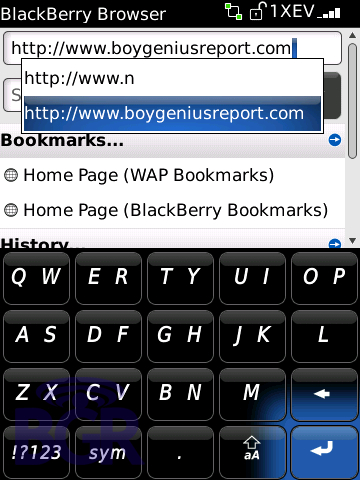
Browser
We’re sorry, WebKit, what? There’s no way in hell this thing is based on WebKit (contrary to rumors from a little while ago) because honestly, it’s the same exact browser that’s on the Bold. Problems loading large pages, death by JavaScript, and so on. Now, the browser isn’t terrible and if you are keeping score, it’s the best browser RIM has ever offered. We just don’t think that’s enough in this day and age, especially when you are trying to go head-to-head with you-know-what. It’s true. Can the browser get you by? Sure. Is it something you want to use? Not so much.
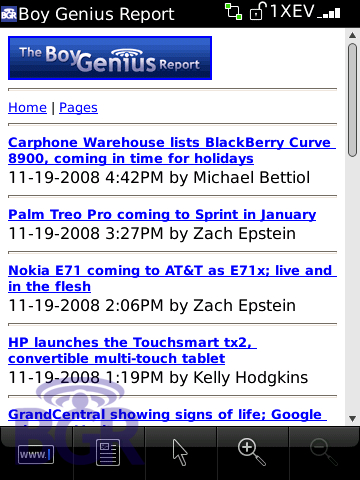
One of the main gripes with the browser is navigation. In most applications there are scroll up and scroll down keys at the bottom of the screen. This is completely necessary in the browser and it’s not available here. What makes matters worse is that like we mentioned, scrolling stops when your finger stops. If you have to scroll down an entire decently-sized webpage, you might need to check yourself an appointment with a BlackBerry thumb / finger therapist because it’s tiring! An easy trick is to flick up the on screen keyboard and use the space key to page down, but what’s the fun in that? We want real scrolling on here.
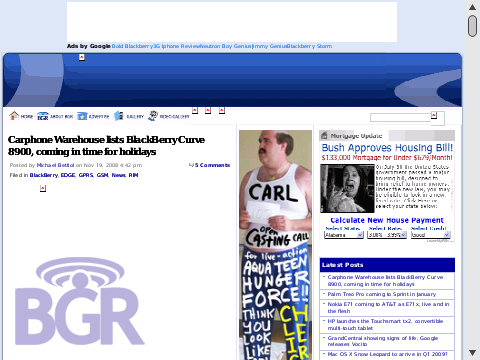
As you can see in the screenshots, it was hit or miss with some sites with images sometimes not loading at all, and we’ve got plently of “An error has occured” messages when trying to browse the internet on here. We’re also not happy with the fact that the double tap doesn’t really work that well. You might have to play around with the touch settings in Options to try and fix this, but on more than one occasion when we double tapped, and then tried to select a link, the unit zoomed in again. Content doesn’t reformat for the screen all that well, and is again, hit or miss.
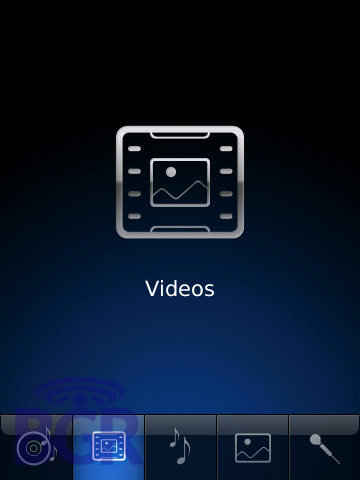
Media Player
RIM’s media player on the device really isn’t all too bad. It’s no iPod but we get a weird sense of joy when we use it. Maybe it’s the way it’s structured or the great blue and black theme, but it works, has minimal issues, and did we mention it works? MP3 playing on here is great. You get full screen album art (well, almost fullscreen) when in portrait mode, and when you turn the device into landscape mode, the content resizes to 100% of the media player window without changing the image proportions (read: stretching, distortion).
Videos look absolutely stunning on here. Probably one of the best video experiences on a mobile device we’ve seen, and probably better than the Bold. First off, the screen is larger, but there’s more than that. Content looks sharp, detailed, has a great contrast ratio, and all around looks almost HD quality. Obviously the quality will depend on the original source and conversion settings you use, but if you’re impressed by the sample video on there, you’ll be blown away when you load in your own video that you’ve encoded in high quality. Great job, RIM.

Applications
We’ll start this up with the first thing you see when you turn the device on… Setup Wizard! God knows how we loathe this damn thing and how annoying it is, but we have to admit, this tweaked version is just what the doctor ordered for any new BlackBerry user. Something about the touch input makes this version of Setup Wizard feel 10x better than other ones. It’s definitely great for someone that has no idea what they are doing and just starting out.
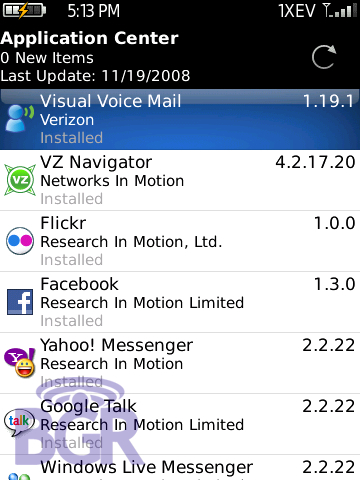
Let’s get negative for a second. The Application Center is probably the stupidest thing we’ve ever seen attempted by RIM. It honestly is. First off, it’s carrier-driven, meaning you can kiss all those applications that matter good bye. That’s not the worst part, though. The kicker is that while it shows a list of applications to install, and show you when upgrades are available, you still have to go in the browser to download them! And we’re not talking like, launch the browser, click one button. We’re talking about accepting RIM’s nutjob three pages of terms and conditions! Absolutely a complete failure and not even worth the effort. Just hit up mobile.blackberry.com and save yourself the trouble. Really, really disappointing.
Brickbreaker and WordMole have been upgraded to take advantage of the new touch-input interface. For Brickbreaker, instead of using a trackball, you now use your finger to guide the paddle. There’s about 1/8th of the screen dedicated to the area where you use your finger, and honestly, we find that we’re better at Brickbreaker this way. It offers more control to the user and is much more precise than using a trackball. Nothing will beat Brickbreaker on the 8700 with the trackwheel, though. Everz.
WordMole, instead of using the trackball to select letters to spell, lets you use your finger to select them. It totally speeds up how fast you can bang out complete words and we’ve gone from 44 second rounds to around 35 second rounds in some cases. Totally hot.
Verizon’s VZ Navigator (we love you, Verizon!) is probably the worst GPS application I personally have ever seen on a BlackBerry. Not joking. It’s visually disgusting and you’re probably better off asking the random guy on the corner of 42th and 5th for directions. We’ll have to wait and see which companies can step up to the plate since the touch screen input is a whole new ballgame. We have faith in our buddies at TeleNav, though!
OS
We’ve said this along, and it’s true. The Storm is a Bold with a touch screen. That’s not necessarily bad, but it doesn’t bode well for RIM who really needs to step their OS up with so many new competitors. The iPhone is popular for a reason. Yes, it’s an Apple product. But getting beyond that, there’s a complete almost desktop-class OS on there that has limitless possibilities. From the networking stack, to the SDK, to the UI, to Safari, they’ve got a pretty serious thing going on. 4.7 is 4.6 is 4.5 is 4.2 more or less. The fundamentals are the same, and the way the OS works is the same. It’s great if you love the default applications and have no complaints, but until RIM really steps the OS up and gives developers the right APIs they need to access you’re not going to see any good 3rd party applications. Yeah, we said it! It’s a pretty bad thing when all the developers that want to develop great applications (SlingMedia, Qik, Skyfire) all need RIM’s assistance because they can’t develop anything on their own.

Specifically talking about the Verizon OS version (4.7.0.65), we’ve experienced a ton of issues with the operating system. (Our Vodafone Storm is also running 4.7.0.65 coincidentally.) The phone sometimes gets hung up if you try and switch the orientation in the middle of typing in a text field and will show a garbled image. Sometimes half of the portrait screen and half of the landscape screen. Then there’s the camera application which has either launched instantly, or taken almost 25 seconds at times with again, a garbled screen image and redraw issues. There’s also a really big bug where if you have a password on your device and go to type it to unlock the phone in portrait mode, after typing the “WXYZ” key, or 9, the phone will ask if you want to make an emergency call. To get around this you have to switch the device to landscape mode and use the full QWERTY keyboard to enter the password.
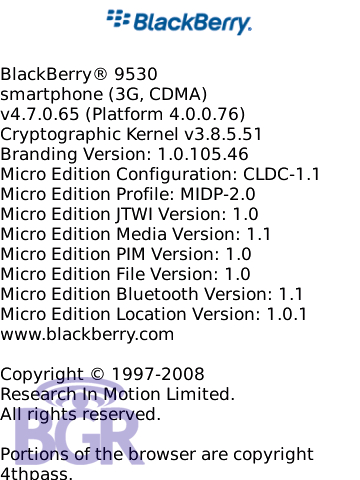
What’s strange is that Verizon and RIM, (RIM hesitated, though) confirmed that 4.7.0.65 was the release the unit would be shipping with and that’s the OS on all our models, but we know for a fact there were newer builds floating around and getting flashed on the retail units for Friday. What’s more, the product sticker on the retail box our Storm came in has an OS version of 4.7.0.82. Pretty stupid of them to give us not final software units to review, right? We’d go and hunt down the .82 release but then we’d be basing our review on something all our friends didn’t have and that wouldn’t be fair. If anything in here is incorrect, blame it on the fact that we got a crappy beta OS version on our review units. Not smart.
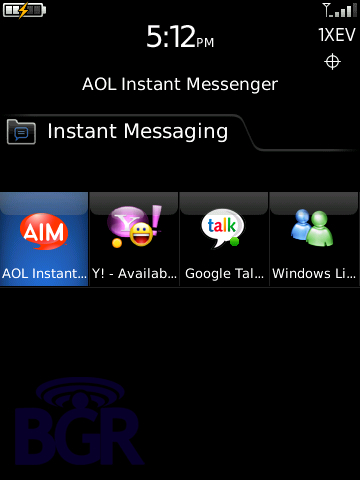
Social Networks and communication
There’s just this thing about RIM’s BlackBerrys that you can’t shake; they are the best devices in the world to keep connected. The ease of snapping a picture and sending it to a BlackBerry Messenger buddy, or to Facebook, or to Yahoo IM is just remarkable. It really lets you communicate more than text so effortlessly and the Storm is no exception. Take the usability factor out of the equation for now. The BlackBerry Storm on Verizon supports AIM, Yahoo Messenger, ICQ, Google Talk, Windows Live Messenger, Facebook, MySpace, Flickr, and BlackBerry Messenger. Plus those are all more or less the best versions of those mobile applications when comparing them to other devices.
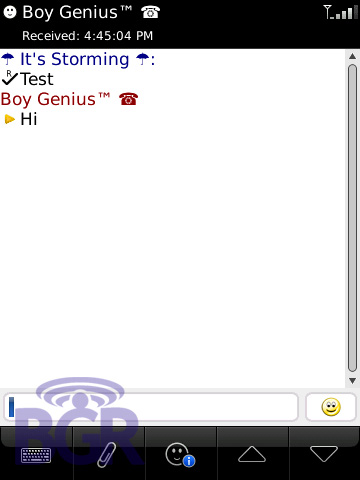
If you can’t stay connected to the people you need to on a Verizon Storm, you’ve got serious issues. Looking at the instant messaging clients, you’ll see a very clean and much welcome redesign. The shortcut keys on the bottom are very necessary and helpful, as is the scroll buttons. Plus we love the added space underneath the conversation windows so you can actually see a preview of a message someone else sent you. On a Bold, or Curve, you only saw the person’s name or screen name.

Daily use
We’ve used two storms over the past four days constantly. First a Vodafone unit for two, and then a Verizon until now. We’d say there’s pretty much nothing we don’t know how to do on here. 90% of it was figured out because it’s pretty self-explanatory, and then when we met with Verizon and RIM they gave us the ill-na-na tips and tricks. In terms of everyday use, this is again going to depend on how much you need to get done, and how much time you have for errors. Make no mistake about it, you will mess up when typing a whole lot more than on your Bold or Curve, and you will have bugs and errors with the device in its current state. Plus, without similtaneous voice and data, it’s rather difficult to keep a hectic workflow going if you’re on the move and always on the phone. The good thing is that this is, afterall, a BlackBerry, and once you get past accepting that there will be some hiccups, it’s really not all that bad. It’s a great phone, a very good device for email, a really good media player, and a decent web browsing machine. You’ll just have to decide what your priorities are in a mobile device and see if the Storms meets that.
There were no catastrophic problems in our daily usage of either device (anyone remember the iPhone 2.0 software actually crashing and you’d have to restore when you were away from a computer?), and if we hit some errors or bugs, a simple battery pull usually resolved them.
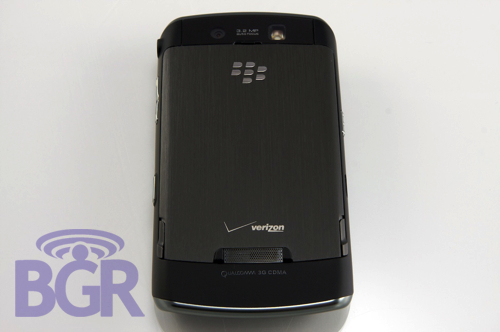
Battery
The Storm ships with a 1400mAh battery. It’s also a totally new model battery that is compatible only with the Curve 8900. Well, the obvious question is, is it enough? Possibly. The first day we used the phone with a full charge, we quickly found our battery depleting faster than we had hoped. There wasn’t even any voice-calling done. Absolutely zero. Just email, BlackBerry Messenger, little MP3 playing, and some light web browsing. If we started the day at 9AM, the unit had around 20% battery life by 4PM. That’s worse than the Bold. Granted, CDMA devices get less battery life than GSM devices in general, so we’re guessing this has something to do with it. Still, we had hoped for more, and if you’re a power user, we strongly recommend you picking up a second battery and an external battery charger. Throw in a car charger and an extra travel charger while you’re at it. We’re just kidding. Kind of.
Remember that we aren’t big on talking on our BlackBerrys so we didn’t really do any hardcore voice-battery testing, just more or less data!

Gripes
This might just be me personally, but I absolutely hate the fact you can not disable auto-rotation of the screen. There are so many times I just want the screen to be in portrait mode and not flip on me that it’s ridiculous. Even when the phone is locked it will still switch orientation on you. It just doesn’t make sense to give the accelorometer permission to move about the cabin all the time. The web browser is one key area here but it’s OS-wide. Sometimes you just want to use SureType because you want to use one hand to type. I had never thought about this, but RIM and Verizon informed us that in the phone application, auto-rotation is disabled and there might be a couple more apps that do disable auto-rotation. Thank the lord! One of them joked that on really early builds the auto-rotation in general would go 360 degrees around (FAIL) and they didn’t want people to start making phone calls with the phone upside down. We laughed.
Besides the auto-rotation, we really have to nitpick about Wi-Fi and tri-band HSDPA. That would have made this an unstopable device even if its difficult to use sometimes. Additionally, we’re not too impressed with the camera on here. Pictures come out very washed out, and while the auto-focus helps, many of our beloved camera shortcuts are gone. The space key used to turn the flash on, off, or to automatic, and sadly, there is no shortcut for that. You’ll have to manually set it in options which is a royal pain in the ass. One neat feature is that the volume up and down buttons also serve as zoom in / zoom out buttons, so they dropped one shortcut but added another.
Something else that is incredibly annoying is the fact that your data coverage indicator, not the actual bars of reception, drop in some applications. For instance, in BlackBerry Messenger, you won’t see 1XEV or EDGE, you’ll just see bars of service. This might not seem like a big deal to some, but as someone who is always paranoid about the data connectivity status, this really bugs the hell out of me.
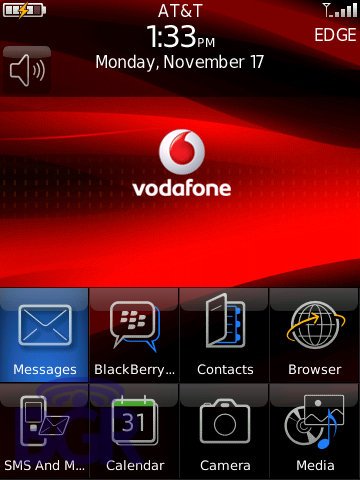
Vodafone-specific:
Contrary to public belief, the unit in the teaser video we posted was not a Verizon unit, it was a Vodafone unit our good friend Marc J. brought us from London. (Dude literally flew here, landed, gave us the Storms and hopped back on a plane to the U.K. two hours later. The definition of a BGR ninja. If you know who we’re talking about make sure you buy him a round of beers at the pub!) The Vodafone units that were shipped to retail are running 4.7.0.65 and are incredible buggy, much like the Verizon unit we have. Forget the screen taking forever to correctly orient itself, the screen would show garbled images when you tried and flip from portrait to landscape sometimes. This wasn’t a regular occurrence all the time, but you could definitely get the feel that the OS was rushed and not a release candidate of what we’d expect from RIM. Same thing that happened with the Bold.
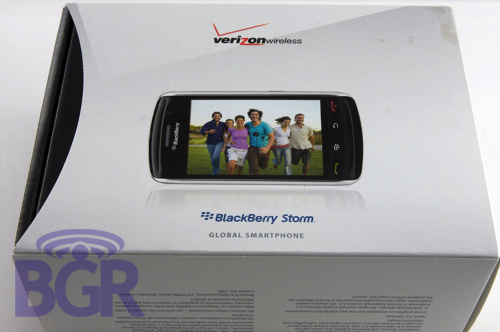
Verizon-specific:
On the Verizon unit you’ve got Visual Voicemail, a first for any BlackBerry, and you’ve got VZ Navigator both pre-loaded. Verizon informed us that since Visual Voicemail is an added monthly feature you have to pay for, it has to be added on your line. The cool part (and great business tactic) is that you can do it right from the device so you don’t have to call in and go through that hassle. Another great feature of Verizon’s Visual Voicemail is the ability to forward a voicemail via email (as a .wav attachment). Another thing we love about the Verizon unit is the theme. Thank the lord above they didn’t mess with success and insist their horrid default themes were on here, because that would have been a major turn off. One difference is with the application center, and the applications. While the YouTube application (which works rather well, even on EDGE) is included with the Vodafone app center, it’s not on Verizons. Google Maps also gets 86’d from the app center on Verizon, but you can always download that directly, and it will work perfectly fine.
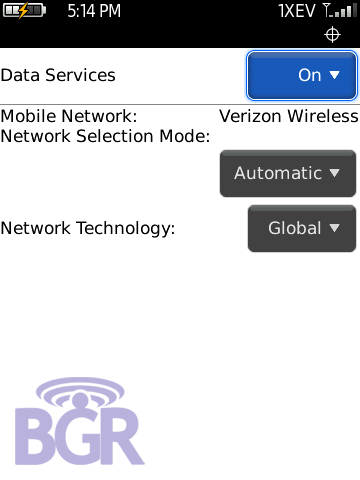
The last difference would probably be how Verizon’s unit lets you selectively set CDMA, GSM, or both (Global) while the Vodafone 9500 unit only allows GSM. All in all, they are 99% the same!
FAQ:
Here’s of some of the smarter, and er, more stupid questions that have people have been asking from day one:
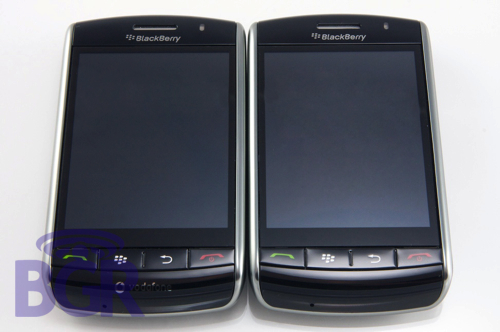
Q: Is the Verizon 9530 identical to the Vodafone 9500?
A: More or less, yes, except for the CDMA chip. According to FCC documents, the CDMA circuitry is actually not in the 9500. That means if you roam in the U.S., you coincidentally will be on either T-Mobile or AT&T and not Verizon. Funny, right? RIM told us that was Vodafone’s request. We also found out that if you travel to another CDMA network in a different country with a 9530, (Canada for instance) you can roam on Telus or Bell’s network since Verizon has those roaming agreements. You’d also be able to manually select Rogers if you wanted to get excited.
Q: Can the 9500/9530 be unlocked?
A: We know for a fact that Vodafone will not be giving out unlock codes, at least in the U.K. as the phone is exclusive to them. We heard people had a ton of trouble getting unlock codes for the BlackBerry 8830 and we’d guess the Storm is in the same boat. That said, the units physically can be unlocked, but you’re better off not going through the respective carriers to get it done since they probably won’t help you all that much. Good luck.
Q: Is there really a “gap” in between the SurePress screen and the housing?
A: Yes, didn’t you read above? It’s definitely there, and while we wish RIM would have minimilized this, we really don’t think this is going to be a major issue. Sure some dust and grizime will get in, but that’s normal and we’d assume thought of during hardware testing. We don’t think it’s a big problem, but it would be nice if the screen didn’t wobble all over the place.
Q: Is the GPS locked down like typical Verizon BlackBerrys?
A: Kind of… The Verizon Storm’s A-GPS is locked to Verizon (the tech that speeds up getting a GPS fix by using the cellular network to triangulate your approximate position) but the actual GPS chip is not. That means you’re free to use any BlackBerry GPS application your hearts desire without any worry of Big Red crippling your dreams.
Q: Is the Storm coming to any other carriers?
A: At this time, no. The full list of carriers is Verizon, Vodafone, Bell, and Telus. That’s it for now. There’s a GSM/HSDPA one in the works which we’d expect to hit AT&T and Rogers with Wi-Fi but that’s a good ways away. Most likely Q2 or Q3 of 2009.
Q: Are you positive that Verizon/Vodafone made RIM remove Wi-Fi at its request?
A. Yes, 100% positive. Verizon’s official statement was something along the lines of, “We’re always looking at additional features and would love to have future devices [BlackBerrys] with Wi-Fi.” If it is any consilation, RIM told us that from the start there was never a Storm with Wi-Fi planned. It was axed from the getgo.
Q. Ok fine, what about the tri-band HSDPA radio? Is there a tri-band UMTS chip in there but the 850MHz/1900MHz bands are software-blocked?
A. Well, software and maybe a little hardware we suppose. The pre-production units all ran 850/1900/2100MHz, and we’ve never seen RIM swap in different chips at the last minute, yet RIM told us there was definitely nothing else in there than the 2100MHz band. Verizon also told us that the Qualcomm chip only supports 2100MHz, but that didn’t make sense to us. We believe them, it just doesn’t make sense…
Q: Honestly guys, why are you so biased? You love the iPhone and secretly call Steve Jobs at his home to talk about plans to conspire against RIM.
A: We’re not and we don’t. We love RIM. They’re our favorite company and we give them a hard time because we expect only the best from them. When they screw up, we give them crap about it. Customers shouldn’t settle for mediocre OS releases riddled with bugs, constant delays and constant push backs from a company that has historically been one of the most solid and reliable. Simple as that.
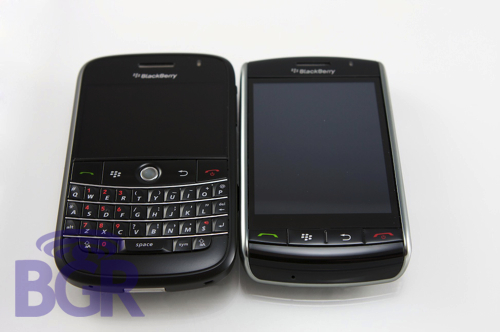
Conclusion
Here’s our honest to god non-biased conclusion… this is the best phone to ever touch Verizon Wireless so far. If you’re a Verizon Wireless subscriber and a dumb phone won’t cut it, you’d be pretty air-headed to not pick this bad boy up above any other smartphone in Verizon’s lineup. It’s the “realest” touch screen Verizon has ever got. Not a piece of crap Voyager or Dare, but a real usable smartphone, depending on your needs. That includes Windows Mobile phones on Verizon for the most part, unless you’re a tech geek that knows what you are doing, then we give you a pass. Please also remember we’re saying this based on Verizon’s current lineup and we’re assuming you have one of Verizon’s less-than-stellar feature-phones. If you have the patience to wait for a Niagara, then god bless you.
The tricky part gets into whether you should switch carriers for the phone like a lot of you are considering. That’s obviously a personal judgment you have to make, but we wouldn’t trade our Bolds in for Storms if you paid us. Like a lot of money. Like, six figures. It’s not that the Storm is a piece of junk for the most part, it’s that it goes against everything a BlackBerry stands for… Quick. Easy. Effortless. The touch screen on the Storm complicates the simplest of tasks sometimes, you lose that lightning fast BlackBerry crack-addict mentality, at least to us.
The whole point of a BlackBerry and what BlackBerry users bragged about to their co-workers, friends and family to was that a BlackBerry was straight-forward and completely uncomplicated. The Storm complicates things. There’s not one thing you can do faster on a Storm than you can on a Bold. Typing is mediocre at best, and to tell you the truth, it really does get tiring at times. It’s not something we can bang out 250-word emails on like we can on every other QWERTY BlackBerry in the past. It hinders your mobile device experience, in our opinion, if you are a raging lunatic on your BlackBerry. It just doesn’t compare to the BlackBerry Bold. At least not in the current incarnation.
At the end of the day, if you’ve been eyeing the Storm, we suggest you either go play with a demo unit at a store, or go ahead and buy one. That way you’ll be able to decide for yourself if you really love the thing, or maybe just don’t care for it. This isn’t a cookie-cutter device, and it’s not for everyone. That said, we’re sure these things are going to fly off the shelves at Verizon stores on Friday, we just have a feeling there will also be a lot of returns.







